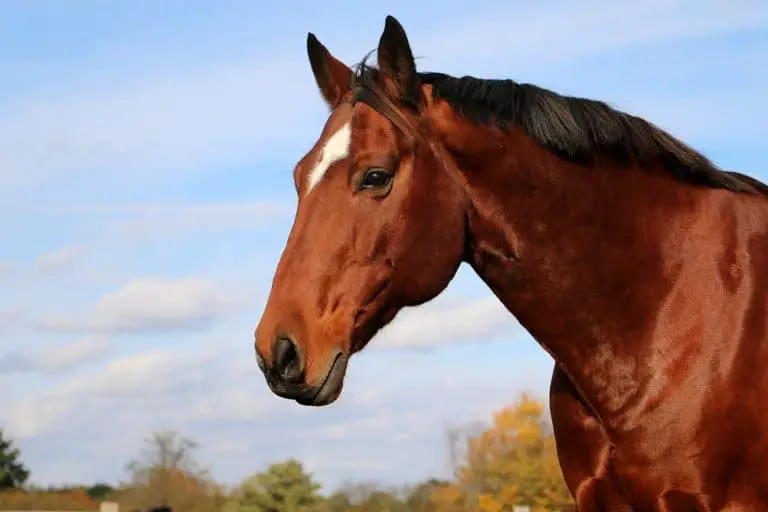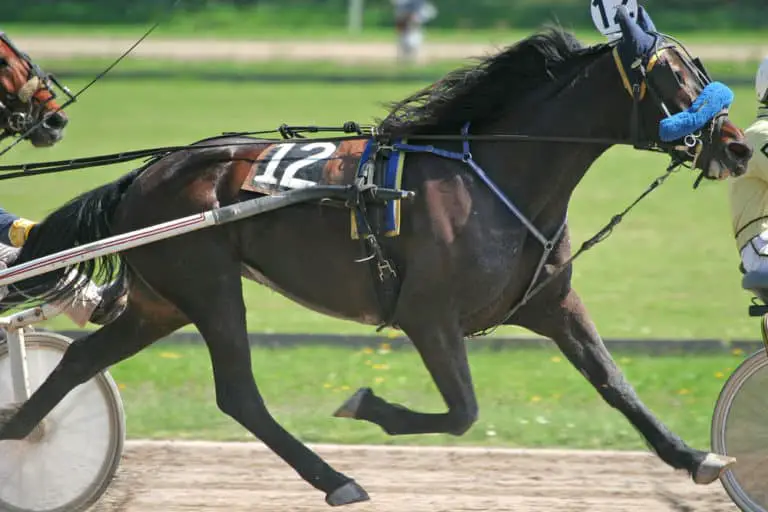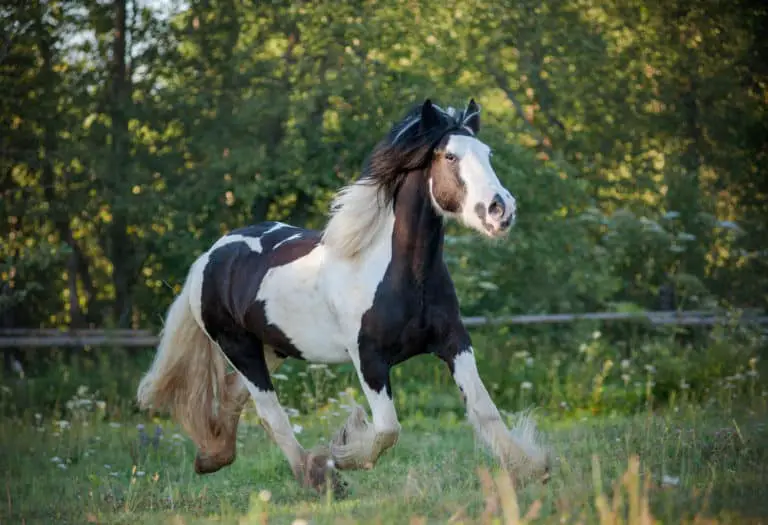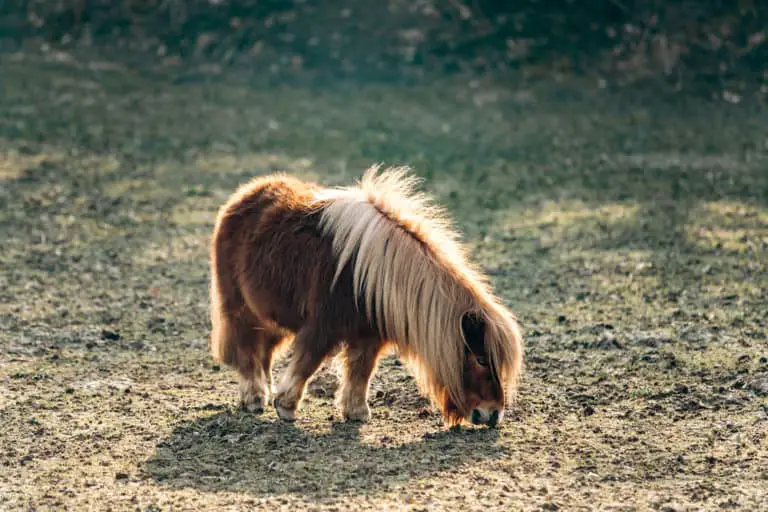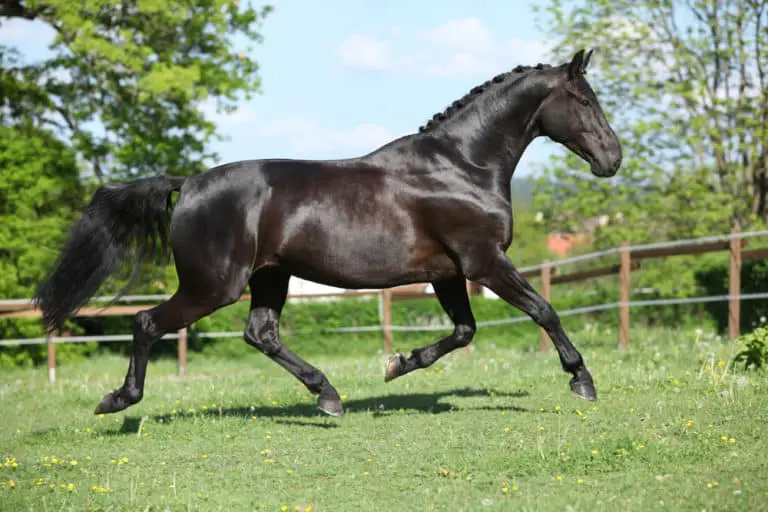Arabian Horse Breed: Care, Cost & History (2024)

The Arabian horse is universally recognized with its dished face and arched tail; even non “horse people” can identify the breed.
Certainly, the breed has a significant influence on modern horses because they helped found so many other breeds and shared their athleticism.
These beautiful horses have galloped through people’s dreams for thousands of years.
Breed: Arabian horse
Adult Weight: 800-1,000 pounds
Adult Height: 14.1-15.1 hands (56-61 inches)
Origin: Arabian Peninsula
Use: Riding, driving, showing, trail riding
Colors: Bay, chestnut, grey, black, and roan
Features: Dished face, large, wide-set eyes, and an arched tail
Lifespan: 25-30 years
Character: Kind, intelligent, and loyal
Gait: Elegant, floating trot, sure-footed, and smooth
Best for: All levels of riders, and they excel in all disciplines
- Characteristics
- Arabian Horse Care
- Arabian Horse History
- Modern Arabian Horse
- Cost and Ownership
- Buying an Arabian
- Similar Breeds
Arabian Horse Characteristics
Generations of careful breeding have developed distinct Arabian horse characteristics. The Arabian horse head features a dished face, large, wide set eyes, and large nostrils in a dainty muzzle.
It’s one of their distinguishing features and connects to an elegant neck, sloping shoulder, short back, and the arched tail. They have clean legs and strong hooves.
Size
The breed standards state that Arabian horse height is between 14.1 and 15.1 hands. (1)
Mares tend to be slightly smaller than stallions and geldings, and non-adult Arabian horse size is proportional to their age. The breed is small compared to others, and there are myths regarding their size.
They originated as Arabian desert horses, and as such, were smaller because they needed to stay in tents with the family and because of the nutrition available.
Their smaller size positively impacts their strength and balance and has allowed unparalleled athleticism – the horses are found in every equestrian discipline, and usually at the highest levels.
Weight
Arabian horse weight averages between 800 and 1,000 pounds. Female horses tend to weigh less than males, and young horses have a weight that is proportionate to their height.
The Arab horse breed has a unique bone structure because they have three fewer bones than other horses. The breed has one less rib than other horses and one less vertebra in their back and tail as well. (2)
The missing vertebra gives them the short back and the arched tail the breed is known for. Their endurance and stamina at running long distances is partly attributed to the missing rib.
Colors
Arabian horse colors include variations of bay, chestnut, grey, and black.
Although the beautiful Arabian horse in The Black Stallion books and movies made black horses famous, the color is not as common as the others.
About half of all Arabians are grey, and bay and chestnut are equally common.
Some horses are roan as well, which is defined as white hairs evenly mixed in with the darker hairs, but roans are rare Arabian horse colors.
Purebred horses are allowed to have white markings on their head and socks or stockings on their legs. The horses all have dark skin bases, with light skin under their white markings.
Temperament
Arabian horses are calm and gentle; the Bedouins developed the breed and shared their tents with their horses and family.
The Arab horse was considered a gift from God. It’s odd that Arabian horse temperament has a high-strung reputation, given this history.
Arabian horse behavior makes them an ideal partner for humans; all that I’ve known bond closely and are loyal animals. The horses are also incredibly intelligent.
United States Equestrian Federation rules allow children to exhibit stallions, although horse shows can make their own rule and override it. Stallions cannot be shown by children in walk-trot 10 and under or leadline. (3)
Arabian Horse Care
Arabian horses require the same amount of care as other breeds and aren’t high maintenance. The horses thrive if their diet and nutrition, health, shelter, social, and grooming requirements are all met.
The average Arabian horse lifespan is 25-30 years, which is the average lifespan for most horses. Diet, genetics, and workload influence lifespan.
Diet and Nutrition
The cornerstone of the Arabian horse diet is forage, a combination of hay and grass and water. All horses need good quality forage that is a source of fiber for maintenance and growth, and to maintain digestive health. (4)
Hay should be tested to understand the nutritional value. (5) It is better to give the horses smaller meals at a higher frequency.
Many horses also eat grain, and this should be carefully fed to avoid health problems but meet nutritional requirements. (5)
Low carbohydrate and low glycemic index grains should be fed. (5) The Arabian horse breed eats less than other regular-sized horses because they are smaller. (5)
Health Problems
The Arabian breed is susceptible to several health issues caused by improper diet and nutrition. These include colic, laminitis, and metabolic issues. (5)
Owners can prevent these conditions by adhering to proper diet and nutrition, avoiding high carbohydrate and glycemic index grains, maintaining a consistent amount of feed, and maintaining the horse’s weight. (5)
There are four common genetic problems in Arabians. (6) The first causes lethargy and death in foals. The second causes neurological problems. A lethal coat color dilution in foals, called “Lavender foals” is the third problem. Compression and cracking of the cervical cord is the final genetic problem; testing is available for all of them. (6)
Grooming
I’ve found that the Arabian horse loves people and the social aspect of daily grooming sessions.
They enjoy the attention, and I enjoy spending time with the horses, it helps us form a stronger bond. It’s also an important part of their daily care. (4)
Arabian grooming begins with a curry comb that stimulates the skin and hair and includes stiff and soft brushes. Hooves should also be cleaned daily, and regular farrier care is essential. (4)
Special attention is given to the mane and tail; they require a bit more time and should be picked through, not brushed, to maintain their full, healthy appearance. (7)
Arabian Horse History
Arabian horse history is long and eventful, with theft, wars, crusades, travel, and exploration all part of their story.
Records show that the Bedouin tribes of the Arabian Peninsula kept their horses and traced their lineage as far back as 3000 B.C. The Arabian horse was family, a status symbol, and a form of currency.
Origin
The Middle East is a harsh climate where only the strongest survived, and the Arabian breed was one of those, adapting to limited water and nutrition. The Bedouin lineage dates back for 4,500 years, making the Arabian the oldest purebred breed.
Arabian horse origin is unknown before the Bedouin records though, and this makes it an interesting mystery as the horse just appeared in Egyptian art. (8)
They were originally bred as war horses; the Bedouins needed fast horses they could ride to raid other tribes. They remained popular warhorses, and their uses evolved over time to modern-day pursuits.
Historic Development
The Bedouin people carefully guarded the bloodlines of the purebred Arabian, passing their breeding program down through generations of family members.
Since the horses were bred for warfare, they were bred for the fastest horses with the most stamina and endurance. Races and other challenges to prove the superiority of horses were frequent.
Raids often involved stealing the horses of another tribe, especially if they had excellent horses and bloodlines.
Throughout history, the Arabian horse expanded beyond the Middle East and was used to found and strengthen other breeds of horses, as the superior attributes of the breed are coveted by all.
Notable Arabian Horses
History is full of famous Arabian horses. They have carried military leaders, founded horse breeds, and starred in movies.
Some, like Thunder, an Arabian horse gelding, are sports mascots. Thunder is at Denver Broncos football home games.
A common denominator among all is the Arabian horse pedigree, their beauty, and spirited movement.
Cass Ole
Cass Ole is better known as the horse in one of the highest-rated equestrian films of all time, The Black Stallion. He also starred in The Black Stallion Returns. Cass Ole was born in Texas in 1969 and had a successful show career before the films. He also sired 130 foals.
Godolphin Arabian
Godolphin Arabian was one of three horses, along with the Darley Arabian and Byerly Turk, responsible for founding the Thoroughbred horse breed. The Godolphin Arabian was born in Yemen, sent to France as a gift for the King, and later imported to England. This Thoroughbred Arabian horse produced foals with incredible speed.
Marengo
The French military leader Napoleon Bonaparte rode a fearless grey Arabian stallion named Marengo. He had imported the horse from Egypt, and despite being wounded eight times in battle, Marengo never threw Bonaparte off. The French lost the Battle of Waterloo and Marengo was exported to England, where he stood at stud.
Myths and Legends
Arabian horse legends entice the imagination. Certainly, horses that were prized as gifts from God, lived in desert tents with women and children and fought wars had ample opportunity to create myths and legends about their origin, loyalty, and stamina. The legends from deep within history show us how treasured the horse was.
The Creation Legend
There is a legend about the origin of the Arabian horse since its history is unknown. The legend states that God took a handful of the south wind, blew on it, and created the Arabian horse. It is said that success is in their forelock, wealth on their back, and treasures on their flank.
The Loyalty Legend
Muhammad, a spiritual leader, proclaimed the Arabian horse was a gift from God. The legend says that he drove his herd of horses through the desert, to an oasis. The horses rushed to drink the water, but he called them back, and only five mares listened. Those five became his favorites and founders of the first breed strains.
The Stamina Legend
Ahmed, a Bedouin chief, was riding his pregnant Arabian mare and an enemy tribe started chasing them. He was shot and slumped over. She carried him home, but a blood mark remained, and the Arabian foal born that night had the same mark on his shoulder. Horses with the blood mark today are rare living legends.
Modern Arabian Horses
The Arabian horse is one of the most popular breeds in the world and their bloodlines can be found in almost all other breeds.
Today, there are six major types of Arabian horses: Egyptian, Russian, Polish, Spanish, Crabbet, and Shagya. The breed is found in all disciplines and corners of the world.
Breeding
The breed is found in over 62 countries worldwide, and Arabian breeding continues in many of these locations.
Of the six types, the Egyptian is considered the purest but represents just 2% of the Arabian horse population. The Spanish type is similarly threatened, at only 1% of the population. Crabbet and Polish types are very popular, and Crabbet is closest to the Egyptian type.
There are also five strains popular in Arabian horses breeding, Keheilan, Abeyan, Hadban, Seglawi, and Hamdani. These were the names of Muhammad’s mares, and these strains are valued higher than the types. They are referred to collectively as Al Khamsa and thought pure.
Population
The Arabian horse population includes over one million horses in 62 countries; the breed is not endangered at all. (9) Of that population, over 663,000 are in the United States, so over half of all the registered Arabian horses. (9)
Qatar is a small country on the Arabian Peninsula and with only 2,774 registered Arabians, is still in the top 25. (9)
People in the United States had beneficial tax credits for breeding and showing Arabian horses until the 1980s, which is why so much of the population is located there.
The Arabian Peninsula had the fewest registered horses for a long time but has rejuvenated their breeding programs. (9)
Uses
Arabian horse uses started with warfare and have evolved into every discipline that equestrians want to pursue, from endurance and trail riding to showing, and from dressage to working cattle.
The breed is extremely versatile, and their athleticism and balance allow them to excel in any sport they choose.
The Arabian horse gait floats across the air, especially at the trot, and they are very smooth to ride. Horse shows with in-hand classes, where the horses are judged on type and conformation, are popular.
Some estimates state that Arabians are over 90% of the horses competing in endurance at the highest levels of the sport.
Arabian Horse Prices
Owning a horse is an expensive venture. It starts with the Arabian horse price, and then the additional ownership costs, feed, board, veterinary, and hoof care need to be accounted for.
It’s important to consider all the costs and make sure they align with your budget before buying an Arabian horse.
Purchase Price
The price of an Arabian horse ranges from $5,000 to $30,000. (10) Stallions, those with rare bloodlines, or competing at the highest levels can cost up to $150,000.
One of the most expensive Arabians, Pepita, sold for nearly $2 million at a sale in Poland in 2015.
The price of each Arabian horse is determined by age (older horses cost less), bloodlines (Al Khamsa horses cost more), the level and type of training, and the number of Arabian horses available in a geographic location.
Purchasing a green Arabian horse without much training costs less initially. But the horse still needs education, costing its new owner money or time.
Ownership Costs
Arabian horse cost of ownership is between $1,770 and $12,930 every year, in addition to the purchase price. (11) Total ownership costs vary based on the Arabian horse price and the geographic location where the horse is kept. Owning a horse is an investment, but the joy the horse brings makes it all worthwhile.
Board
Board is the term used for the stabling or shelter a horse needs. All horses need protection from the weather and natural elements, and a place to exercise. Arabian horse board cost ranges from $1,200 to $7,200 each year, the final price is determined by location and type of board. (11)
Feed
Feed fulfills the horse’s nutritional requirements, and usually includes hay, grass, grain, and supplements.
Hay and grass, collectively referred to as forage, are extremely important for horses. Arabian horse feed cost is between $250 and $4,380 per year, depending on how much hay needs to be purchased versus feeding grass, and other factors. (11)
Vet Care
Horses need veterinary care each year to maintain their health levels through routine vaccinations, dental care, and preventative checkups.
The average Arabian horse veterinary cost is $200 to $350 per year. (11) Unexpected injuries or sickness, including laminitis and metabolic disorders can easily add $500 to $1,000 to that price each year. (11)
Hoof Care
The average Arabian horse hoof care cost is between $120 and $1,000 per year. (11) Horses need their hooves trimmed every six to eight weeks by a farrier, and some also require shoes. Arabians in horse shows, endurance, and other disciplines are shod. Although Arabians tend to have strong hooves, ask the farrier what the horse needs.
Buying an Arabian horse
The Arabian breed is majestic and extremely personable. But it’s important to meet the horse and see if you click. Visit multiple Arabian farms and try numerous horses. You may end up buying the first horse you meet, but visit many, and then go back. A horse you bond with becomes a lifetime partner.
Is the Arabian Horse Right for You?
Riding an Arabian horse helps determine if the horse is right for you. It’s best to try riding the horse in the discipline you want to pursue, and at the walk, trot, and canter.
Each horse has a unique personality, and there is an Arabian to match the personality of every rider. This breed is best for people who want to spend a lot of time with their horses, bond with them, and ride.
Anyone, from a beginner to an experienced rider, can succeed owning an Arabian if they meet the horse’s needs and keep them active. The horses want to be part of your life and they want to have a job.
How to Buy an Arabian horse?
Beginner riders should look for horses ages 10 to 15 that are already trained in their preferred discipline. Experienced riders may consider buying a young or green horse and investing in Arabian horse training.
Visit an Arabian breeder and then a few more. Evaluate at least three horses; beginners should go with a trainer or instructor. Ride all the horses before buying an Arabian horse or extending your search.
You want a horse that is kind, intelligent, fun to ride and behaves well. Avoid horses that are high-strung, spooky, or mean. Finally, have a veterinarian check the horse before completing the purchase.
Similar Breeds to Arabian
The Arabian horse is unique and beloved for its beauty and athleticism. But, since the breed helped establish so many other types of horses, there are many Arabian breed alternatives.
The Akhal-Teke and Barb both originated in the Middle East like the Arabian did, while the Thoroughbred developed with Arabian blood and has similar worldwide appeal.
Akhal-Teke
The Akhal-Teke is a horse breed from Turkey, and like the Arabian horse, is known for its speed and endurance. They are also very intelligent horses and were bred by the Turkmen tribe, originally for raiding other tribes. The horse’s coat has a metallic sheen, and they are called “Golden Horses.”
Barb
The Barb horse of North Africa is hardy, with stamina and endurance. They were frequently mistaken for Arabians in Europe, but are a separate breed with their own characteristics, they are fast, love to learn, and gentle. Although not quite as pretty as Arabian horses, they also influenced many other breeds.
Thoroughbred
Thoroughbreds descend from Arabian horses and are popular worldwide. The breeds are still a popular cross today, producing Anglo-Arabians. Although Thoroughbreds tend to be longer and taller, both are sensitive and intelligent, while also fast. The Thoroughbred has heightened sensitivity and is not as hardy as its ancestor but possesses similar beauty.
FAQ
What is an Arabian horse?
Arabian horses are the oldest purebred breed of horses, known for their beautiful appearance and incredible stamina and athleticism.
What does an Arabian horse look like?
Arabian horses have beautiful heads, with a dished face, wide set eyes, and large nostrils. They have a small body and an arched tail.
How did the Arabian horse get its name?
The Arabian horse is named for the Arabian Peninsula where the breed originated from.
Can you ride an Arabian horse?
Yes, you can ride an Arabian horse. They were bred to be ridden and are popular in all disciplines.
Are Arabian horses good for beginners?
Yes, the Arabian horse is good for beginners, they have a gentle and quiet temperament.
How tall is an Arabian horse?
Arabian horses are between 14.1 and 15.1 hands, or 57 to 61 inches tall.
How much does an Arabian horse weigh?
Arabian horses weigh between 800 and 1,000 pounds.
How big is an Arabian horse?
Arabian horses are small to average size in terms of height and weight. Some Arabian horses qualify as ponies.
How much does an Arabian horse cost?
The average Arabian horse cost is between $5,000 and $30,000 to purchase a horse.
How much does Arabian horse ownership cost?
Arabian horse ownership costs between $1,770 and $12,930 each year.
How long do Arabian horses live?
Arabian horses live for 25-30 years.
How fast can an Arabian horse run?
The fastest Arabian horses can run up to 40 miles per hour, and the average speed is 34 miles per hour.
How much can an Arabian horse pull?
Arabian horses can pull between 1,200 and 1,500 pounds.
How much can an Arabian horse carry?
Arabian horses can carry between 160 and 200 pounds.
At what age is an Arabian horse full grown?
Arabian horses are full-grown at age six, slightly older than other breeds.
What are Arabian horses used for?
Arabian horses are used for and excel in all riding and driving disciplines, from showing to endurance, and leadline to jumping.
References
- Arabian Horse Association. 2019. Arabian Confirmation. Link
- Arabian Horse Association. 2022. Arabian Horses. Link
- United States Equestrian Federation. 2022. AR Purebred Arabian. Link
- Arabian Horse Association. 2022. Basic Needs (of Equal Importance). Link
- World Arabian Horse Organization. 2009. Practical, Safe, Nutritional Programmes for the Arab Horse. Link
- World Arabian Horse Organization. 2007. Genetic Disorders in Arabian Horses. Link
- Cynthia Richardson, United States Equestrian Federation. 2018. Arabian Horse Mane and Tail Care. Link
- Arab Horse. 2013. Arabian Horse History. Link
- World Arabian Horse Organization. 2022. Link
- Arabian Horse Association. 2022. Marketplace. Link
- Arabian Horse Association. 2022. What is the Cost of Providing for Them? Link

